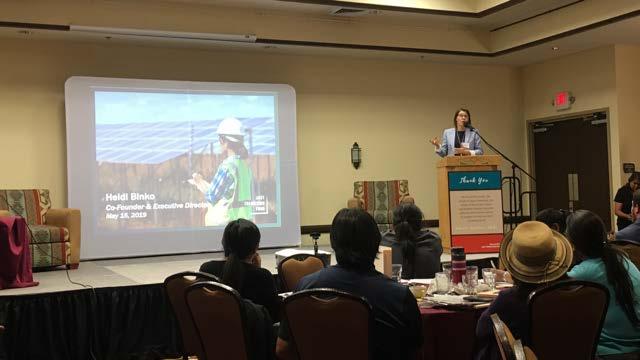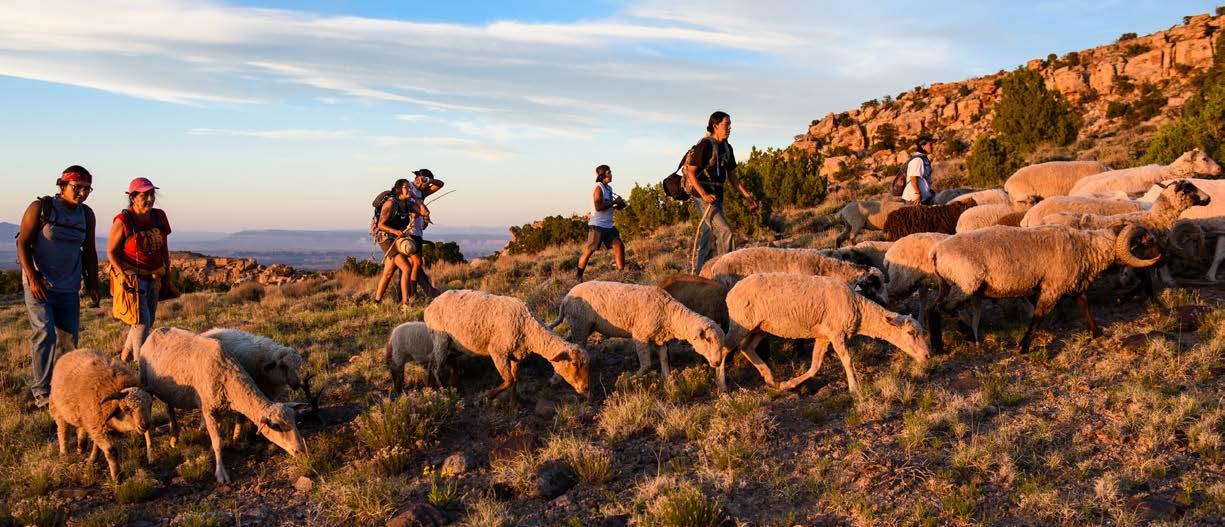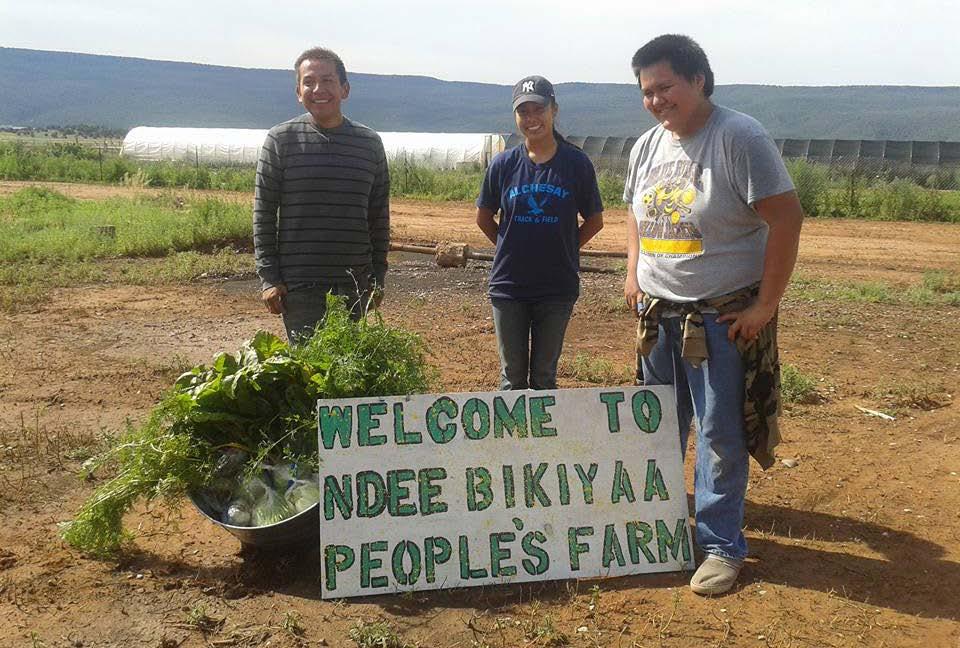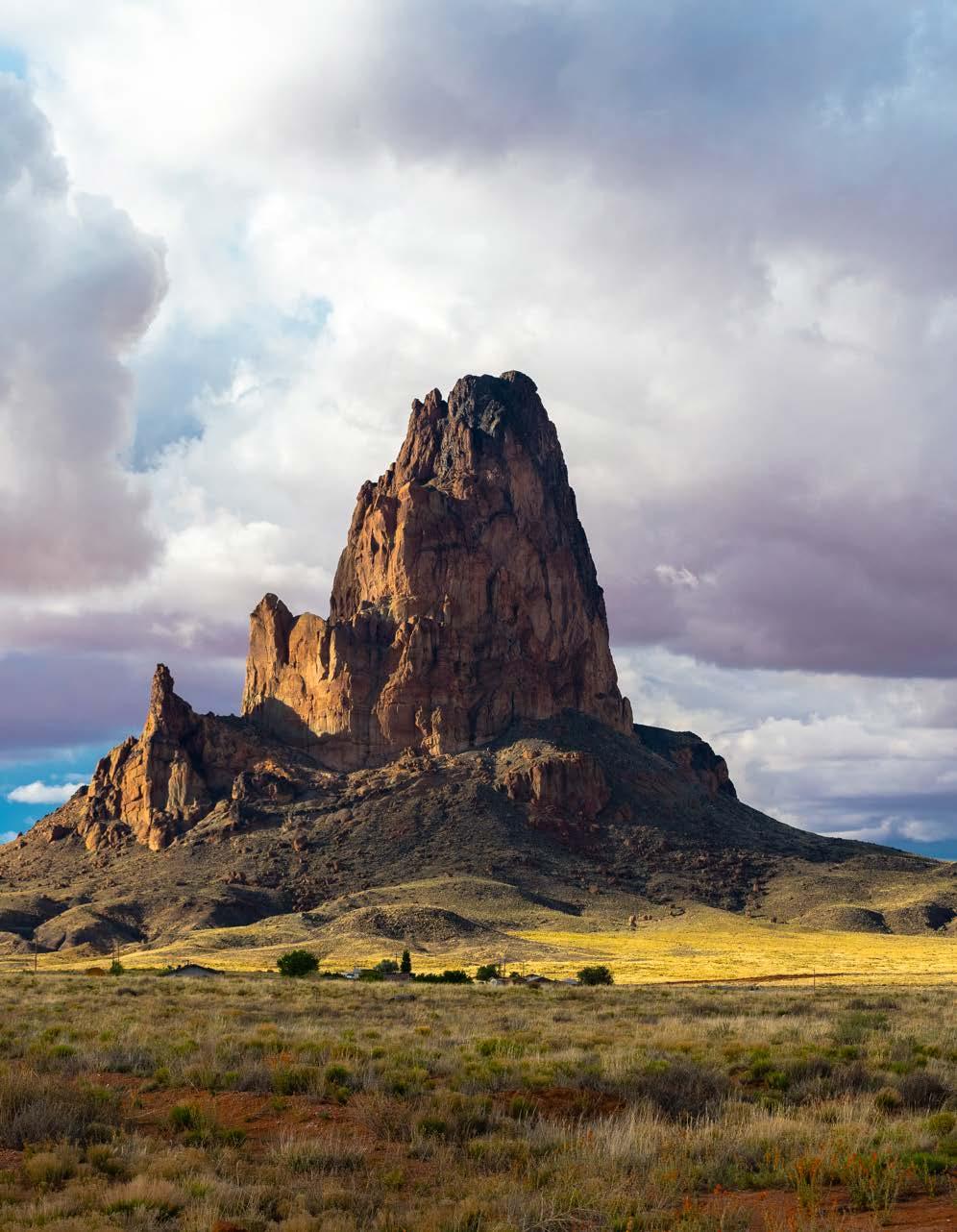
11 minute read
A NEW WAVE OF NATIVE NATION-BUILDING
Today, Native leaders across the Colorado Plateau are innovating new systems and new markets to meet their communities’ needs to sustain Native languages, protect water, advance community led agriculture, and protect sacred places.
NEW WAVE OF NATIVE NATION-BUILDING
The market is what tribal governments have to carry out much of the work that they do. Their economies are set up under federal supervision and protection. That’s what the trust relationship entails. But Native led nonprofit organizations are not locked into that. And so the idea of creating new markets, markets based on a different form of what we would call economy that isn’t tied to the capitalist structure, but it’s more sustainable and organic and flexible. I mean, to me that is amazing, because you can think of solutions that actually fit the reality of tribal governments.
– Rebecca Tsosie
Now, we have extractive industries that are leaving our communities and we still don’t have an economy. We still don’t have an economy – you know, people are just losing their jobs basically. And so for me, that’s the reason why we have to go back to our own cultural values, the way we think about life, the way we think about how we use resources, how we use time, and the time that we spend with our families.
– Jessica Stago
And then, of course, there’s the people who are not trying to work within the economic model and actually just trying to make programs happen on a local level. I guess the thing that I’m always sensitive to is not trying to commodify – you know, trying to hold that tension between needing an alternative economy and…how do we also create space for things that are just outside of that realm?
– Sonja Swift
In some cases, these new systems exist entirely outside of the economic structure and instead involve Native-driven models of education or cultural preservation. These models stand in stark contrast to the historical trend of non-Natives coming into tribal communities with their own ideas of the work that needed to be done.

A lot of that formal cultural affiliation work Hopi has done generated a lot of information and data that can now be turned around and implemented back into the community. So it is being taught in school; there is a Hopi curriculum based off of this traditional knowledge. You can take that and put it into the school system or some nonprofit organization and give them those resources so that they can disseminate that how they see fit. It’s not just doing the work for some federal agency. Now it’s about, again, placing Hopi as a priority and feeding that information back…we’ve flipped the script so to speak. We did what early ethnographers and anthropologists were doing. We did it for ourselves and now instead of saying, “okay, we’re going to build a career off of this,” like they do in academia, we’re going to say, “now, we’re going to give it back to the people that it came from and allow them to develop their own idea of cultural preservation.” Because, like I said, I learned cultural preservation in the home. Now it’s being taught outside of the home, but we want to bring it back into the home. So it’s about giving individual communities out at Hopi, families, villages, whatever resources so that they can read it and then reinterpret themselves or and give it back to their own communities.
– Lyle Balenquah
In other cases, the new systems intentionally exist within the market structure, and aim to provide culturally-grounded ways for Native people to support themselves.
All people aren’t always going to be in to traditional food movements for culture; people are going to want to be in for actual financial gain. People aren’t just going to want to go work an eight-to-five job, go home, and then take care of the field like I am. People are going to want to just go home and rest. And so what I’ve been thinking of is creating a farmer training program. My big drive next year is to create that so we can get young people trained and growing fields for production for local consumption and create the local markets. But also hooking in with the markets that are there, like the schools, like the casino. And then looking at other non-traditional farming methods. For example, we constructed a 30 by 96 foot hoophouse that allowed us to grow year around in the fall and winter and into early spring. Having that access to those resources and showing people how to build those resources and the infrastructure so that they can grow year round. That way they can have their own skills and own farms and that they can start carrying this movement forward, and they’ll be producing it, hopefully for the locals here, and for the community. And really that’s what it’s about for me, creating healthy food and making traditional foods accessible, especially to the community. And maybe that’s how we keep it all going.
– Aaron Lowden
Native people are navigating how we can pick from what we need in terms of technology and innovation and make it work on the reservation – utilize it in a way that allows us to live and to make a living within our cultural values, but also allows us to promote those values.
An inspiring example of a regenerative Native-led economy has emerged from the White Mountain Apache Tribe’s efforts to advance food sovereignty on their reservation. The Tribe was facing high rates of diabetes and obesity
NEW WAVE OF NATIVE NATION-BUILDING on the reservation among tribal members. In addition, as is the case for many Tribes, there was only one grocery store (and not a major supermarket) on the reservation to meet the needs of 12,000 to 13,000 residents.

Ndée Bikíyaa (The People’s Farm) began on land that was originally used as a for-profit hay farm in the 1980s and then, due to various issues, laid dormant for thirty years. As the White Mountain Apache Tribe pursued its water rights settlement, the Tribe brought 15 acres of the land into organic food production in 2010. Today, food grown on the farm includes traditional Apache food such as corn, garlic, onions, peppers, tomatoes, squash, and potatoes. The food grown on the farm is distributed across the reservation, to schools, elderly centers, the fitness center, and other tribal institutions on White Mountain Apache. It is also sold at the farm store and at the on-reservation farmer’s market. Ndée Bikíyaa has had to overcome many challenges as it’s grown to meet tribal needs. This includes the lack of appropriate federal policies that fit the unique situation of a tribal farm meeting on-reservation needs. To address this, the White Mountain Apache Tribe is in the process of implementing its own tribal food code to fill regulatory gaps around food safety and other policies.
While Ndée Bikíyaa is now operated solely as a tribal enterprise, future plans include forming a non-profit arm to expand community education and outreach efforts around food security and food sovereignty. One of the things that makes Ndée Bikíyaa unique in the tribal food movement is that its mission extends beyond growing and selling food. It also includes a strong community education, youth outreach, and capacity-building component. These are all designed to increase community understanding and engagement in soil restoration, farming practices, traditional food, and other technical assistance to tribal members who want to garden and farm.
Ndée Bikíyaa has made an intentional effort to frame its approach around traditional White Mountain Apache systems and beliefs, including placing non-monetary value on contributions of knowledge and farming traditions.
Ndée Bikíyaa Project Manager Danya Carroll shares:
A regenerative economy is a traditional food economy, there is a different way that people approach food. In years past, people would trade and barter in a way that everyone was taken care of and there was a mutual exchange. Part of that has been lost and that is part of what we’re trying to bring back. Placing more value on people’s skills and knowledge, including traditional farming and irrigation methods. At Ndée Bikíyaa, we are trying to promote balance, respect, and empowerment and bringing value back to the people that grow the food and contribute to the larger food system – hunters, gatherers, wild plant harvesters. You can make different things other than money when you pay attention to elders who know so much about food and plants. We can’t completely go back to ancestral times, but the knowledge of our ancestors helps us build the overall health and well-being of our community.
At the same time, Ndée Bikíyaa has a strong interest in also pursuing agri-business opportunities. This work has the potential to demonstrate ways for farmers to support themselves through their farming work, and also move the farm toward achieving financial sustainability. Much of Ndée Bikíyaa’s work today is grant-funded, and one opportunity that hasn’t yet been realized is for its funders to share knowledge about potential pathways for the farm to achieve financial sustainability. Similar to the thoughts shared by other interviewees, Danya Carroll also noted that it can be hard for Ndée Bikíyaa to quantify results for a grant report, even when there is a real, tangible positive impact on the community. She also noted the need for funders to design and implement evaluation practices that are beneficial and culturally-relevant to the community, as well as to the funder.49
Markets such as those nurtured by White Mountain Apache and other Native leaders on the Colorado Plateau can lead to community transformation and modern Native nation-building.
Tolani Lake Enterprises and North Leupp Family Farms on the Navajo Nation in Northen Arizona just wanted to farm. And that whole region now has farmers and this small, growing industry of farming-led ideas and everything from a farmer’s market to a cafe to somebody tackling the issue of water rights. Somebody with an idea then grows into a community, but then that community decides that there’s a bigger issue, such as water rights, that needs to be tackled, and they realize they’re the ones that need to do that and that their voice needs to be heard. And so I think that philanthropy can grow those movements, those smaller movements within communities that start with just one person having an idea….If one person has an idea and somebody sees them doing that and then obtaining access to resources, whether it’s to start a business or to start a nonprofit, it grows, it begins, and they attract more people. It’s hard to see that there are those creative people there who live on the reservation that want to start these things. And also people who are off the reservation, a lot of Native youth who are off the reservation who want to come back. But really coming back to the reservation doesn’t mean you are going to have a job here, but that you have to create your own job here. And that is something I think philanthropy can have a hand in.
– Jessica Stago
Despite the need for and impact of strategic philanthropic support, the obstacles to accessing these resources remain huge within Native communities on the Plateau. Even considering the small percentage of Native Americans in the United States population (2%), funding is disproportionate, topping out at a high of 0.59% and largely directed towards urban initiatives, arts, and culture.50 Problems on the Colorado Plateau extend beyond that fact. Native communities in rural environments such as the Colorado Plateau, with programmatic foci that extend to food or protection of lands and waters, do not receive significant amounts of the limited philanthropic support available. And if the “commensurate with the population” argument is extended to the Colorado Plateau, where the proportion of the Native population dwarfs the national 2%, the funding gap becomes even starker.
PHILANTHROPIC FUNDING TRENDS, 2002–2016
0.4%
Average share of annual grant dollars explicitly benefiting Native Americans, 2002–2016
Over a 15-year period, from 2002 to 2016, large U.S. foundations gave an average of 0.4 percent of total funding to Native American communities and causes. The proportion ranged from a high of 0.6 percent in 2006 to a low of 0.3 percent in 2009, 2010, and 2014. The share of number of grants awarded was more stable from year to year and averaged 0.5 percent.
Some have argued that philanthropic funding for Native Americans should be, at a minimum, commensurate with the proportionate size of the population in the U.S.16 The American Indian and Alaska Native population (including those of more than one race) represented 2 percent of the total U.S. population in 2016,17 and the population is increasing at a faster rate than the total U.S. population.18
Source: Investing in Native communities: Philanthropic funding for Native American communities and causes. (2019). Candid and Native Americans in Philanthropy. (p. 14).
Fluctuations In Funding
Figure 6 shows funding explicitly benefiting Native Americans in the Four Corner states in 2015 and 2016. While this information is useful and the best up-to-date data for this region, it is critical to keep in mind that the Colorado Plateau is a rural sub-area encompassed by the Four Corner states. The Plateau itself does not include the major urban areas of Albuquerque, Santa Fe, Phoenix, Tucson, Denver,
A NEW WAVE OF NATIVE NATION-BUILDING MODERN NATIVE MOVEMENT-BUILDING ON THE
Boulder, or Salt Lake City. Thus, while the numbers shown in Figure 6 are the best available data for the Four Corner states, there is a data gap with regard to funding on the Colorado Plateau itself; all told, the dollars reaching the Colorado Plateau’s Native communities are undoubtedly a significantly smaller subset of Figure 6.
FIGURE 6. PHILANTHROPIC FUNDING EXPLICITLY BENEFITTING NATIVE AMERICANS IN THE FOUR CORNERS STATES IN 2015 AND 2016
Even when the limited amount of support does become available for their work, Native communities and initiatives on the Colorado Plateau still have significant hurdles to overcome to access those funds.
And the Native person who gets a grant funded, that’s somebody in our community who can ignore the trauma, who can stay inspired despite every day issues with their family and their community, dealing with tragedy, not having access to the internetwho gets past all of that to write a proposal that’s awesome and that gets the attention of a funder. But that doesn’t happen very often.
– Jessica Stago
NEW WAVE OF NATIVE NATION-BUILDING
And I think a lot of it has to do with the access to those resources. I think that if people knew resources that were easier to gain access to, then there would be a lot more going on within our communities. I think that philanthropy folks can learn more about being better allies to our communities by just not making it so hard to get access to these resources.
– Aaron Lowden
First it’s, “How do we even get the support or attention from philanthropy?” And when we did get it, it’s been a situation where we are struggling to stay in line with the timelines that are set forth. And negotiating timelines. I feel like we’re always negotiating time. And throughout my work, with anything that I’ve been doing, we’re always explaining why this hasn’t happened and it is usually because of some process that’s put in place, either by the federal government or by the Tribe because of the federal government, that’s hindering development or hindering what we would want to see in terms of impact. So I think it would help if philanthropy could say, “Okay, you tell us what your timeline needs to be” versus “Well, we need this money spent within the next quarter or within the next year.”
– Jessica Stago
And basically, the point is just being led by the lived experience; I’m just so intent on that piece because philanthropy has just predominantly existed where the lived experience of the people who are making the decisions is not very often in alignment with the experiences of the issues that they’re trying to solve. And there’s just, there’s a big gap in that and ways of thinking are perpetuated that are in misalignment.
– Sonja Swift
Today, leaders in philanthropic giving on the Colorado Plateau are evolving to support priorities that authentically emerge from tribal communities. Whether through the leadership of Native-led foundations, the hiring of Native program officers, or deep listening between grantors and communities, a call to action is being heard by the larger philanthropic community to invest in nurturing these new, innovative Native-led markets and systems that are transforming and healing the Colorado Plateau.









